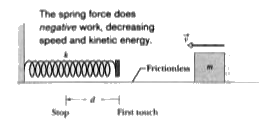InterviewSolution
Saved Bookmarks
| 1. |
When a spring does work on an object, we cannot find the work by simple multiplying the springforce by the object's displacement. The reason is that there is no one value for the force-it changes. However, we can split the displacement up into an infinite number of tiny parts and then approximate the force in each as being constant. Integration sums the work done in all those parts. Here we use the generic result of the integration. In Fig. 8-13, a cansiter of mass m = 0.40 kg slides across a horizontal frictionless counter with speed v = 0.50 m/s. It then runs into and compresses a spring of spring constant k = 750 N/m. When the canister is momentarily stopped by the spring, by what distance d is the spring compressed? |
|
Answer» Solution :KEYIDEA 1. The work `W_(s)` done on the canister by the SPRING force is related to the requested distance d by Eq. 8-26 `(W_(s)= -1//2 kx^(2))` , with d replacing x. 2. The work`W_(s)` is also related to the KINETIC energy of the cansiter by Eq. 8-10 `(K_(f)-K_(i)=W)`. 3. The cansiter.s Kinetic energy has an initial value of `K = 1//2 MV^(2)` and a value of zero when the canister is momentarily at rest. Calculations: Putting the first two of these ideas together, we write the work-kinetic energy theorem for the canister as `K_(f) -K_(i) = - 1/2 kd^(2)`. SUBSTITUTING according to the third key idea gives us this expression: ` 0-1/2 mv^(2) = -1/2 kd^(2)`. Simplifying, solving for d, and substituting known data then give us `d = V sqrt(m/k) = (0.50 m//s) sqrt((0.40kg)/(750 N//m))` `= 1.2xx10^(-2) m = 1.2 cm`.  Figure 8-13 A canister moves toward a spring. |
|